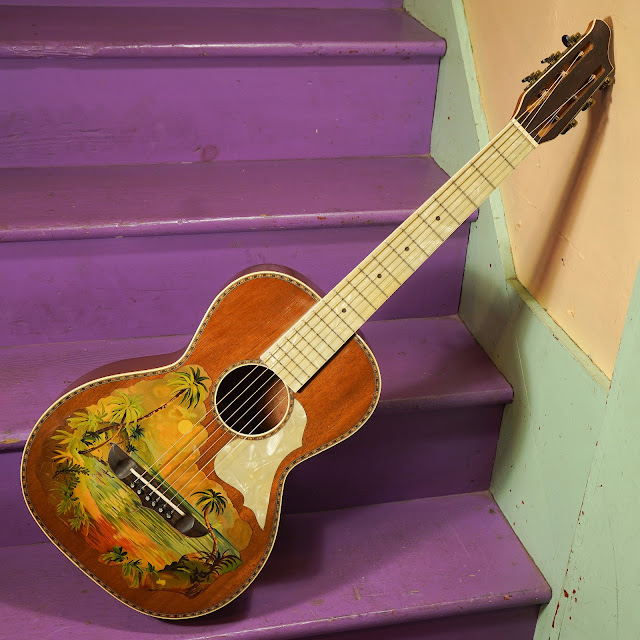1920s Stromberg-Voisinet (Kay) Hawaiian-scene Parlor Guitar
This model of guitar always feels like deja vu to me because I've worked on so many of them. It was made by Kay (called Stromberg-Voisinet at the time) in Chicago and the body is solid mahogany throughout with a ladder-braced top. It's got a shorter (24 1/4") scale length with a big V-neck and, of course, it looks amazing.
These often feature nice wooden purfling along the top edge and lavish decal scenes on the top -- both things this guy has. It also has a pearloid-veneer fretboard and pearloid pickguard. Throw-in a three-point, pyramid-style bridge and a pointed "Gumby" headstock and you've got lots of cool going on.
Someone had done all the heavy lifting on this guitar before me (neck reset and saddle-slot recut) so I only had to do glorified setup work to get this ready and humming. It now plays spot-on and perfectly and is one of the best-sounding versions of this model that I've played yet. It's loud, woody, and punchy and has good "pop." A lot of fingerpickers are drawn to these when I have them in the shop because of this.
Repairs included: fret seating and level/dress, side dots install, bridge pinholes fill/redrill, setup, etc.
Top wood: solid mahogany
Back & sides wood: solid mahogany
Bracing type: ladder
Bridge: ebonized maple or similar
Fretboard: maple with pearloid veneer
Neck wood: poplar
Action height at 12th fret: 3/32” bass 1/16” treble (fast, spot-on)
String gauges: 52w, 40w, 30w, 22w, 16, 12
Neck shape: big V
Board radius: flat
Neck relief: straight
Fret style: thin/medium-tall
Scale length: 24 1/4"
Nut width: 1 3/4"
Body width: 13 1/4"
Body depth: 3 3/4"
Weight: 2 lbs 11 oz
Condition notes: no cracks, all original save newer saddle, only mild wear/tear/scratching throughout. The bridge had a tiny hairline crack (not through) along the old bridge pin holes, but I filled/moved the bridge pins farther aft and repaired that so it's good to go. Like on many of these, the fretboard top is slightly concave due to the celluloid shrinking. This meant that the frets needed to be seated/glued in their slots with a little bit of fill -- which I've done. This also makes them "feel" slightly taller/more rectangular in shape than they really are -- a bit like tall bar frets -- so if you mash your frets when sliding you won't like the feel, but if you're more of a light touch on the left hand you will not notice at all.
It comes with: a good, slightly-oversized hard case.




















Comments